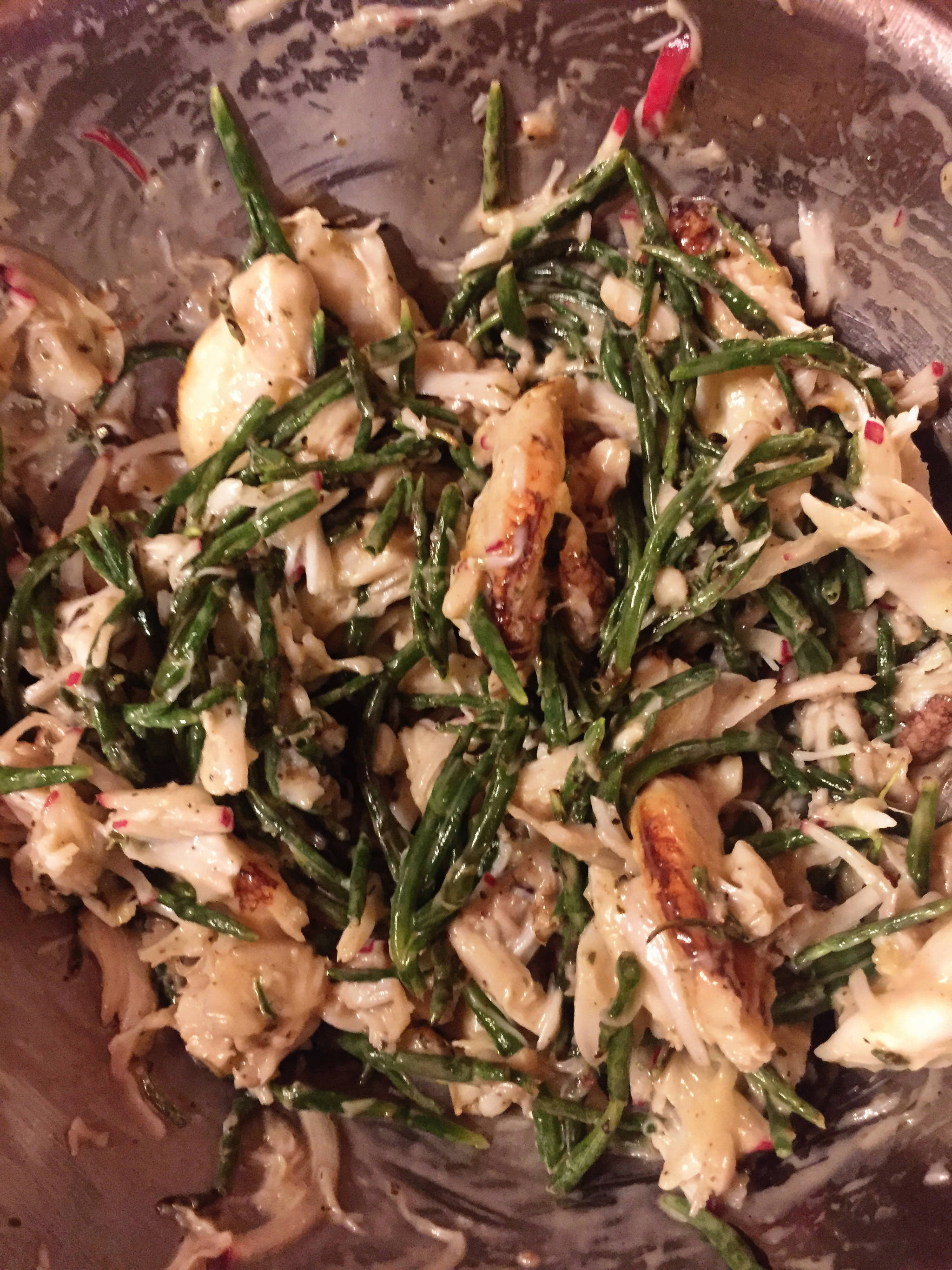“It’s July in Juneau in your mouth!” was how my friend Kate described this beach asparagus, Dungeness crab and tarragon salad.
This is how you spend a Saturday night when one of your best food buddies is in town. It was midnight and after tossing around ideas, and raiding our friend Traci’s fridge, we had a late-night taste test that proved we’d hit on a keeper.
If you’re unfamiliar with beach asparagus, this succulent marsh-loving plant is possibly my favorite foraged vegetable. I’ve recently seen it available for purchase at both IGA Foodland and Rainbow Foods. As far as I can tell, beach asparagus is only called beach asparagus in Southeast Alaska, although it grows in similar climates around the world. The plant’s fashionable name is “sea beans,” in Britain you’re more likely to see it called salicornia or samphire, and in Turkey, deniz borulcesi. One of the dozens of other common names for this plant is a dead giveaway for one of the best uses of beach asparagus — “pickle weed.” Using a basic pickle recipe, beach asparagus is truly the best pickle you’ll ever have.
When I’ve got beach asparagus in my fridge, I throw it in every single dish. In its raw form, beach asparagus has a perfect crunch. You’ll find this plant in low sandy marsh areas that are covered only at the very highest tide. Beach asparagus retains a delicious saltiness which balances against a slight sweetness and “green” flavor, all of which combines beautifully with sweet Dungeness crab, tarragon and lemon.
We sat down and ate this salad straight out of the mixing bowl. To share, serve cold with crackers or crostini, or serve individually over a simple salad of lightly dressed greens.
Blistered Beach Asparagus & Dungeness Crab Salad
• Prep time: 10 minutes (45 if you have to cook and shell your crab)
• Servings: 4
• 1 cooked dunganess crab, shelled
• 1 handful beach asparagus (~ 1 heaping cup), cleaned and torn into 1” pieces
• 2 radishes, matchsticks
• ½ lemon
• 2 tbsp mayo
• 1 tbsp fresh tarragon, finely diced
• Salt & pepper to taste
In this recipe we “blistered” half of the beach asparagus we used. The blistered beach asparagus is a little sweeter, and slightly less crunchy than the raw beach asparagus. I really enjoyed the variety in texture, but this recipe is delicious if you use all raw or all blistered beach asparagus.
If your crab isn’t cooked, break in half by cracking down on the breast plate, either with a chef’s knife, an awesome rock, a fence post, or whatever else you think might work. I typically quickly grab the crab’s legs, one side in each hand, and crack the crab’s breast plate on the sharp corner of my porch. Pull off the top of the shell and scoop out the guts. Fill a large lidded pot with 1 inch of water, put your steamer rack in there, bring to a boil, add your raw crab halves and cover. Steam for about 8-10 minutes per crab, or until the shell is bright red and the meat is opaque white. Remove and cool either in an ice bath or run under cold water. There’s a bunch of different ways to cook a crab, but I think steaming results in the most tender meat. If you’ve got a live crab on your hands and don’t feel up to cracking it in half before cooking, you can always steam them and then clean, but you’ll need to steam them a little longer.
For the blistered beach asparagus, get a large cast iron screaming hot. Make sure your beach asparagus is dry and throw half of the beach asparagus in the hot skillet without any oil. Toss and cook until just browned, about 2 minutes. If you’re going to blister all of your beach asparagus, you may need to do it in batches to ensure that you’re not over-crowding the pan. Once browned, mix with the rest of the ingredients.
Be sure to wait and taste your final salad before you salt. Beach asparagus is naturally salty, and depending on where it comes from, can be very, very salty. You can also choose to add the second half of the lemon ahead of time or serve with a slice of lemon. I liked more lemon than Kate did, so I’d say, as you do with salt and pepper, use your own judgement.
Erin Anais Heist is a food blogger in Juneau. Readers can contact her at foodabe.com, or on Instagram or Twitter at @erinanais. “Eating Wild” recipes publish every other week.

